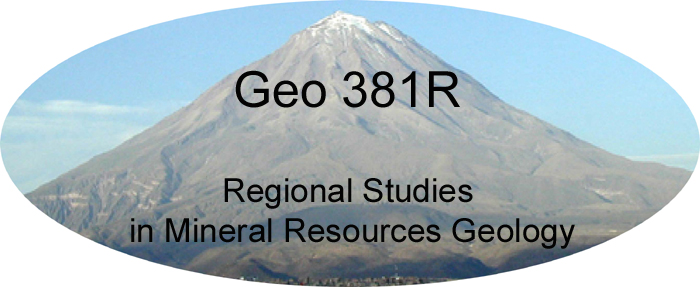
GEO 381R Field Excursion to the Chilean Andes
In May, 1999, a combined group from the University of Texas
at Austin, New Mexico Tech, and the University of Utah spent three weeks in
northern Chile, experiencing the spectacular tectonic and volcanic geology of
the central Andes, the stark terrain and climate of the Atacama Desert, and the
worldclass mineral deposits. The
trip was a fabulous educational opportunity for students with interests in
tectonics and subduction-related magmatism ((Karah Wertz, Tip Meckel), ore
deposits (Asif Muzaffar, Jim Corboy), and climate-related weathering phenomena
(Joy Griffin, Tony Troutman), as well as Pre-Columbian history and Andean
culture. The trip followed a Spring
Semester seminar in which the graduate students studied various aspects of the
geology of the region in GEO 381R Regional Studies in Mineral Resources Geology.
Each student prepared a section of a guidebook for the trip.
The trip included 10 geologic professionals who shared
invaluable experiences from the real world of mining and mineral exploration.
They and their companies also provided field vehicles and per diem
support that helped make the trip affordable for the students.
The Geology Foundation provided scholarships to cover most of the
international airfare for the students, thus making the trip an incredible value
for the students.
Chile is the world's leading copper-producing country, so
predictably the trip was dominated by tours of various types of copper deposits.
These deposits are hosted by Mesozoic and younger igneous rocks of a
variety of types. The deposits are
complex mineralogically, as the result of the variability of the original copper
concentrations and the overprint of weathering phenomena associated with the
hyperarid climate of the Atacama Desert.
The trip started in Copiapo, following an overnight bus
ride from Santiago. The first visit
was to the Candelaria copper deposit in Mesozoic metavolcanic strata, arguably
the most controversial deposit of the entire trip.
Next was a tour of El Salvador, the subject of many classic studies of
the relationship between hydrothermal alteration and "porphyry" copper
mineralization. El Salvador also
provided the only underground mine experience for the group.
We toured the new Manto Verde copper deposit, an interesting variety of
structurally controlled copper mineralization without a genetically associated
pluton. A day was devoted to
regional geology, including tracking the Atacama fault and coastal batholith
complex cut by spectacular dike swarms. We
ended up at the coastal town of Taltal from which we ventured out to examine
three manto-type copper deposits in Mesozoic andesitic volcanics.
Traveling further inland, we toured El Guanaco, an interesting study in
metal zonation from a high-level gold-rich deposit that becomes increasingly
copper-rich with depth. Lomas Bayas
provided an example of the climatically induced complexity to near-surface
copper deposits in the Atacama region, where the high nitrate and chlorine
content of the secondary ores complicates copper recovery via the solvent
extraction process. The nearby
Fortuna deposit illustrated a well-evaluated copper resource that awaits better
metal prices before production can commence.
El Abra, at 4200m elevation, provided the high point of the trip, with
one of the world's largest copper producers against a backdrop of snow-covered
Andean volcanic peaks. Mina Sur
(Exotica), the last copper deposit visited on the trip, was also one of the most
spectacular. Mina Sur formed where
groundwater, carrying copper derived during weathering of the nearby supergiant
Chuquicamata porphyry deposit, precipitated secondary copper minerals within the
matrix of Tertiary gravels forming a high-grade "exotic" deposit.
The Tejanos stayed after the conclusion of the mine trip to
see some of the other geologic features of northern Chile in the San Pedro de
Atacama area, one of the few habitable sites within the heart of the Atacama
region. This trip provided many
additional experiences, including an earthquake in Calama and a surreal sunrise
at 4,000m elevation at the steaming El Tatio geyser field after arriving in the
freezing dark. We visited the Salar
de Atacama, which contains the world's largest lithium producer from the
interstitial brines beneath a rugged evaporitic crust; the limited water in the
salar hosts a thriving biological community including a flamingo colony.
The visit was punctuated by an impromptu concert from a Chilean folk
group on the return bus to Calama. The
students made their way back to Santiago with an intermediate stop on the beach
at La Serena.
As was advertised for the course, the trip should not be confused with a vacation. Although everyone returned bone-tired, an unforgettable experience was had by all participants.
Modified from story by Rich Kyle in the 1999 DGS Newsletter
 |
||
|
|| Home || Introduction || Syllabus || Spring '09 trip description || Canada Travel || Sources || Related Sites || Chile 1999 || Peru 2000 || Spain - Portugal 2001 || Western Australia 2003 | |
||